phnx.par
svx.f

Also see this ppt presentation
How to build Pisa from scratch:
Step-by-step
| (1) | Run with current description:
phnx.par svx.f | 
|
| (2) | Remove old lampshades:
phnx.par svx.f | 
|
| (3) | Insert new standdalone geometry of Michael Malik's:
phnx.par svx.f | 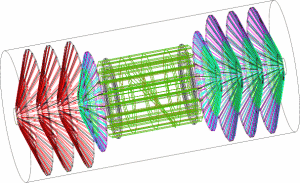
|
| (4) | Fix rotation matrices, color attributes, cleanup
phnx.par svx.f (24 aug 04) | 
|
This still has the old organization of Michael
* HALL * ( Single-letter vol names ) | * ( get prefix TRP, for example ) SIEN (VTX Envelope/Cage) * ( A -> TRPA ) | * SICG (VTX cage inner surface) * | * +---------------------+------------+------------+ * | | | | * TRP1(72) TRP2(72) TRP3(24) TRP4(24) * | | | | * +-+-------+----+----+ ---+--- ---+--- ---+--- * | | | | | * A E M BOX1 BOX2 ( ----- Structure repeats 4 times ------ ) * | | ( Under TRP2, A -> B etc, CHP1 -> CHP2 ) * +---+ +---+ ( Under 3, A -> C etc 1 3 ) * | | | | ( Under 4, A -> D etc 1 4 ) * I CHP1 Q CHP1 * * TRP1,2 are the big lampshades North and South, TRP3,4 are the small lampshades N and S |
||
| (5) | Change organization to closer conform to old structure:
svx.f (26 aug 04, b) |
*==================== The tree structure for the endcaps is: ============================ * * HALL * ( Single-letter vol names ) | * ( get prefix TRP, for example ) SIEN (VTX Envelope/Cage) * ( A -> TRPA ) | * SICG (VTX cage inner surface) * | * ++----------------------+----------++ * || || * SI05,9 SI06,7,8 - 10,11,12 * || || * +----+---++-------+----+ +----+---++--------+-----+---+ * | | | | | | | | | * C,D G,H O,P BOX1 A,B E,F M,N BOX1 BOX2 * | | | | * +---+--+ +-+--+ +------+ +------+ * | | | | | | | | * K*,L* CHP3,4 S*,T* CHP3,4 I*,J* CHP1,2 Q*,R* CHP1,2 * * SI06,07,08 are the big lampshades North * SI10,11,12 are the big lampshades South * SI05 and 9 are the small lampshades N and S * The *starred* volumes are sensitive silicon |
|
| (6) | Active volumes
Now we need to make the calls to declare active volumes. For this you need to specify the complete path from HALL down to the sentitive volume, and identify it with a unique name of an already existing volume on that path. There is no way to do this without rearranging some more. Also we can simplify more, since K=L, CHP3=CHP4, S=T etc. svx.f (7 sep 04) * HALL * ( Single-letter vol names ) | * ( get prefix TRP, for example ) SIEN (VTX Envelope/Cage) * ( A -> TRPA ) | * SICG (VTX cage inner surface) * | * +------------------+---------------+--------------------+ * | | | * SISB(6) SISS(2) (barrel) * | | * SIPB(24) SIPS(24) * | | * +--+-----+---+----+-----+ +--+------+--+----+ * | | | | | | | | | * A E M BOX1 BOX2 C G O BOX1 * | | | | * +--+--+ +--+--+ +--+--+ +-+---+ * | | | | | | | | * I* CHP1 Q* CHP1 K* CHP3 S* CHP3 * * SISB are the 6 big shades, containing 24 SIPB panels * SISS are the 2 small shades, containing 24 SIPS panels * The *starred* volumes are sensitive Silicon *Now the unique paths can be labeled: I, Q, K and S. |
| (7) | Back to geometry:
The lampshade panels have silicon (I,Q,K,S) hanging over the edges of the carbon support panels (A,C), but the mother volumes were only as big (in x,y) as the carbon. This is not allowed, so the mother volumes were enlarged to encompass the silicon. Since these volumes (SIPB, SIPS) now overlap in space, they have to be declared 'MANY' instead of 'ONLY'. This forces GEANT to search up and down the geometry tree in order to resolve ambiguities. Each set of lampshade panels was therefore enclosed in a PCON mother volume SISB or SISS (for big and small), in order to limit this searching to within one lampshade only. On the right is a vertical section through a portion of a lampshade. The big lightblue arcs is the SISB pcon mother volume. In black are the carbon support panels, on which sit the red carbon standoff strips. On this are placed the readout chips (CHP1, light blue), and on top of those is the silicon (TRPI, magenta). The last two are enclosed in a black mother volume TRPE. The red trapezoids (SIPB) enclose all items belonging to one panel. These red volumes overlap.
| 
|
| (8) | Tiny geometry details:
Each silicon detector and its readout chips are placed in a mother volume, for example I and CHP1 sit in E. E has the same x,y size as the silicon, but is thicker in z because of the chips. In the location where inner and outer silicon overlap and almost touch, the thicker mother volume I touches the underlying silicon, even though the si detectors themselves do not touch. In order to eliminate these volume overlaps, we do away with the thicker mother volumes E,M,G and O, and place the silicon I,Q,K,S and the readout chips CHP1,3 directly into SIPB and SIPS. svx_11sep04a.f svx_15sep04a.f
HALL
7 7 HALL
( Two-letter vol names ) |
( get prefix SI, for example ) SIEN (VTX Envelope/Cage)
( CB -> SICB ) |
SICG (VTX cage inner surface)
|
+------------------+---------------+--------------------+
| | |
SISB(6) SISS(2) (barrel)
| |
SIPB(24) SIPS(24)
| |
+---+----+-+---+----+-----+ +---+----+--+---+----+
| | | | | | | | | | |
CB S1* SCHP S2* SBX1 SBX2 CS S3* SCHP S4* SBX1
SISB are the 6 big lampshades, containing 24 SIPB panels
SISS are the 2 small lampshades, containing 24 SIPS panels
The *starred* volumes are sensitive Silicon
After this, I did a massive cleanup of the code, and renamed volumes.
|
| (9) | Massive conflict with the re-defined barrel
I turned out the barrel folks had changed their geometry also, intruding into endcap space. After picking up the new phnx.par, a cross section through the x-z plane looks like this: | 
|
| Here is figure 5.2.2 from the
mechanical design report.
It shows the services of the first endcap going out in a radial
(from the vertex) direction.
The re-defined 4th barrel layer conficts with these services. | 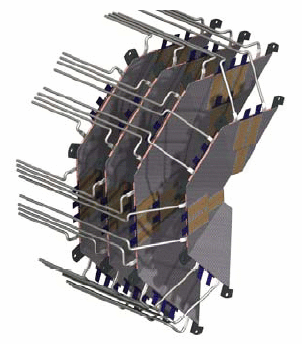
|
| (9) |
What is more important is the mechanical rigidity of the barrel. In the design
on the right you can see that the barrel is supported between two disks, each of which
connect to the outer shell of the detector via a cone.
A barrel support that is forced to zigzag around barrel and endcap layers is like a bellows structure, and much less rigid. | 
|
| (10) | Radiograph showing 'layers': 1-4 = green, 5=black, 6=red,
7=blue, 8 =magenta.
Note that the innermost barrel has almost no hits on it. The bottom graph shows the hits on each layer, with a few on layer 1 and a few hundred each on layers 2-8. svx_19sep04.f svx01_19sep04.C svx03_20sep04.C | 
|
| (11) | Reorganized the layers, so they correspond to
the endcaps. This was done by using GSPOSP instead of GSPOS which lets you
place multiple copies of a volume with different sizes.
Layers 1-4 are the barrel (black), and the endcap layers are now numbered
5-12 going in the positive z direction (left to right).
These plots were made from the output of pisaRootRead,
indicating that the software downstream of svx.f can properly find and process hits.
| 
|
|
The volume tree structure is now simplified, and we can use SI05-SI12 to identify the sensitive volumes. This structure is now completely analogous to the barrel organization.
HALL
|
SIEN (VTX Envelope/Cage)
|
SICG (VTX cage inner surface)
|
+------------------+------------------------+---------------------+
| | |
SI05,06,07,10,11,12 SI08,SI09 (barrel)
| |
SIPB(24) SIPS(24)
| |
+-----+--------+----------+--------+ +-----+--------+----------+--------+
| | | | | | | | | |
SICB SISI(4)* SCHP(22) SBX1(2) SBX2(2) SICC SISI(4)* SCHP(16) SBX1(2) SBX2(2)
SI05 - SI12 are the lampshades, 6 big and 2 small
each lampshade containing 24 panels, SIPB or SIPS
Each panel consists of carbon support, silicon(4), readout chips(22) and
standoff strips(2x2)
| ||
| (12) | Code cleanup, involving removal of almost all variables from
phnx.par. Only the z-positions of the lampshades is left for the user to play with via
the phnx.par parameters.
Committed to CVS: svx.f phnxSili.par | 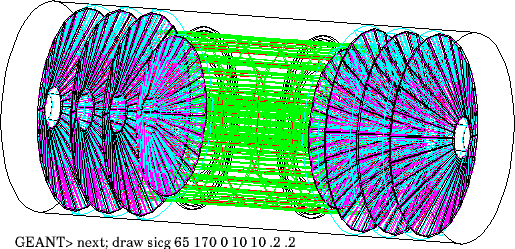
|
The relevant section from phnxSili.par is:
$sili_endcap_par sili_endcap_type = 1, sili_endcap_layers = 8, sili_endcap_z = -35.16, -29.16, -23.16, -17.87, 17.87, 23.16, 29.16, 35.16, $endThe type is (for the moment) a dummy flag that allows us in the future to switch to completely different configurations. | ||
| (13) |
gif jpg png xcf (Gimp) gsdfgs sg sdgsdfgsdf gsdf gs dfgsdfgsdfg sdfg sdfgsdfgsdfgsd fgsdfgsdfgsdfgs d Also see pictures at ../strawman.html. |
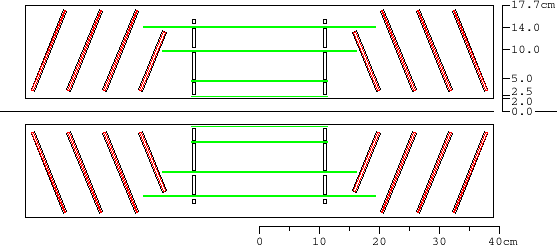
|
In the drawing below, a blue line is drawn at angle y=1, along the edge of
layers 2,3 and 4 of the barrel. The first two silicon endcaps are reduced to
start 1 cm
away from this line, in order to allow for support structures, cooling
services and power and signal cables. Also in blue are lines indicating the
central arm acceptance. On the bottom half, red lines indicate the muon arm
acceptance for an 'interaction diamond' of z=+-10 cm.
See
newendcap_2.html or
review_jan05.html
for more details.
|
Formats available:
gif jpg png |
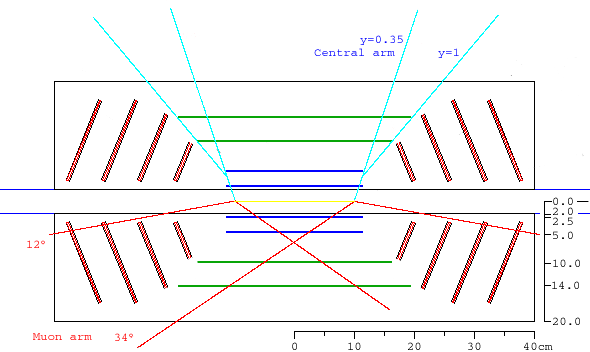
|
|
There are now 3 different endcaps. The panels that make up the lampshades
(24 per shade) are shown here. The size of the new small panel is determined
by the size of the inner silicon (pink).
formats: png, gif, jpg |
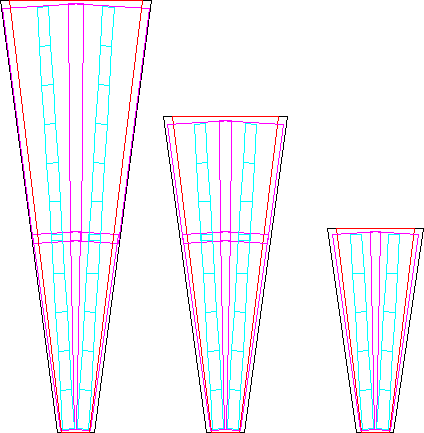
|
||||||||||||
|
Note that in order to get enough clearance between the small lampshade and the 3rd barrel layer, the small shade was moved out in z. formats: png, gif, jpg | 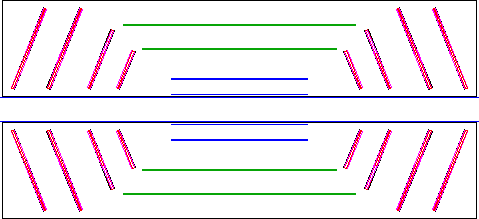
|
| Support structures are added in the cone-shaped area between the endcaps and the barrel layers (blue). Notice the two red disks supporting the barrels in this figure. These were in there from the past, left over from when the strip layers (green) had the same z-extent as the pixel layers (blue). These red supports are now removed from the code. | 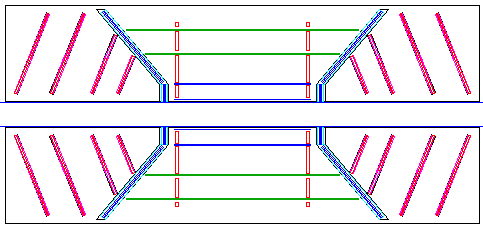
|
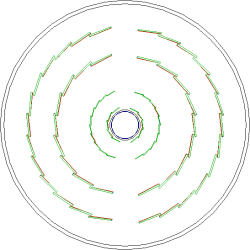
| The support structure lampshades have a 24-fold symmetry. A cross-section detail is shown |
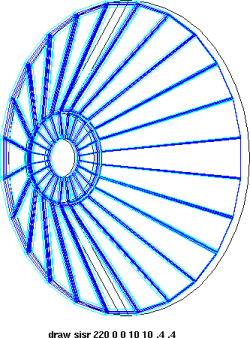
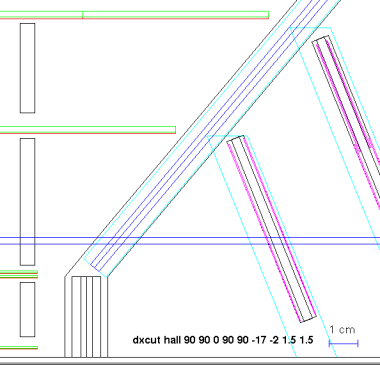
|